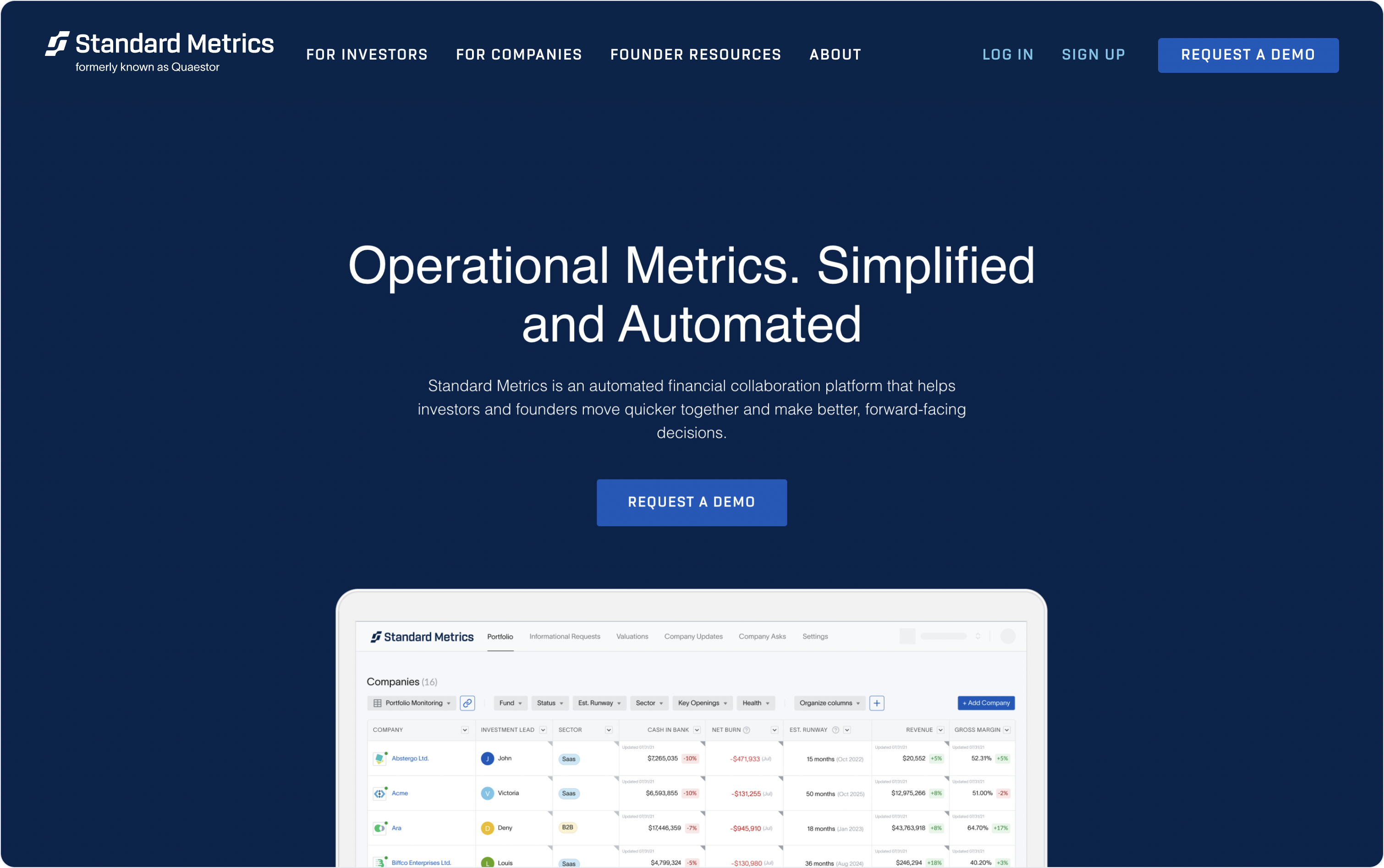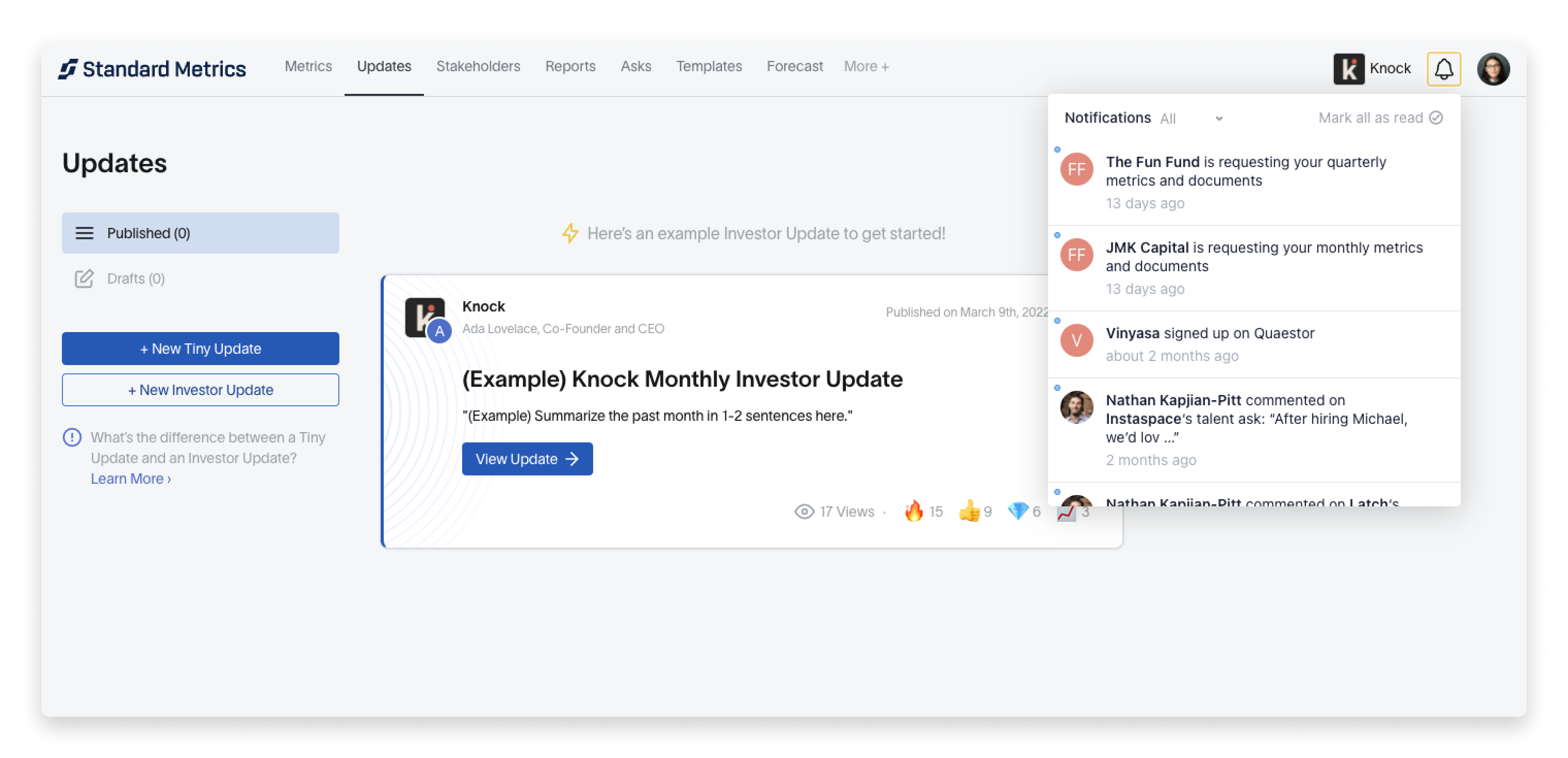
Standard Metrics is a financial collaboration platform that helps startups and investors share data and work with one other. If you’re a startup, you run your investor updates and your KPIs through Standard Metrics to keep your investors up to date on how you’re doing each month. If you’re an investor, you use Standard Metrics to keep tabs on your portfolio and get an idea of how they’re doing across a standard set of metrics.
If they sound familiar, it’s probably because they were recently featured on Packy’s Not Boring newsletter. If you want to learn more about the service they provide for founders and investors, his post is a great place to start.
Helping startups and investors collaborate on financial and business metrics
Standard Metrics was founded on a single question: “why is it so difficult for startups and investors to collaborate around financial data and business metrics?”
Every day their team tries to answer this question by shipping product that help startups and investors collaborate.
At first, Standard Metrics only used email to notify its users when they had pending actions in the product. This could be a reminder for a founder to update their metrics for the month or for an investor to respond to an ask from a founder.
The problem: it was hard for users to find all the actions they needed to complete when landing in the Standard Metrics dashboard from an email notification. It was easy to get lost in different pages and miss an action that needed to be completed.
“We looked at building guides in the product or onboarding flows,” says Kevin Hsu, co-founder and Head of Product, “but in-app notifications seemed like the natural extension of our email notifications in helping us route new and existing users to the high-value actions our users needed to take in the product.”
And so the product team at Standard Metrics started to evaluate its options for shipping an in-app notification feed to their product to help users complete their reporting and action items in Standard Metrics.
RFC: build notifications in-house or use Knock
As the team evaluated their options, it quickly came down to one of two choices: build in-house or use Knock.
The team drafted an RFC to evaluate an in-house build v. Knock across the following criteria:
- Correctness
- Maintainability
- Development time
- Flexibility
- Performance
The team found Knock and an in-house build to score evenly across correctness and performance, but they decided to use Knock because of the benefits it brought in development time, flexibility, and maintainability.
Development time
As the team evaluated an in-house build, they realized there were two months of work to do across the backend and frontend to get an in-app feed live in production.
On the backend they’d need a per-user store of notifications that they could add to and query for each user’s individual feed (which would also need to be scoped by tenant,) as well as create new models to support all of that functionality. This meant tables for notifications, notification read status, and notification preferences.
On the frontend they’d have to build a component with support for querying notification data, dismissing notifications, detecting read and seen status, and displaying the count of unread notifications, all in real-time.
The team got access to the Knock beta and within an hour they had a fully-featured in-app feed live in their product.
“Knock helped us ship a best-in-class solution to our problem in under an hour. It was mind-blowing how quickly we got it working in our product.” — Kevin Hsu

The Knock in-app feed in the Standard Metrics dashboard.
Flexibility
As the team added more notification types, they started to realize the benefits in flexibility and accessibility they were gaining through Knock.
“I’m able to log into Knock as a product-person and immediately understand what’s happening in our own product notifications,” said Hsu. “I’m able to visualize what’s happening in our own product when a customer does something that triggers a notification, I know exactly what’s going to happen next.”
It gave engineers the ability to quickly make and test updates, and it gave the product team visibility into the notification engine driving customer engagement for the first time. Now any user at Standard Metrics can jump into the notification system and make edits to notification logic and templates.
Maintainability
Finally, by choosing Knock, Standard Metrics gets the ongoing support of a partner that obsesses over one thing and one thing only: notifications infrastructure. This has enabled the Standard Metrics team to focus on their core product roadmap and their growth, knowing that their notifications infrastructure will scale in the background without eating into valuable engineering time.
“At Standard Metrics we’re going to focus on our core competencies as a company. For everything else, we’re going to find the service providers that are the best in the world at their particular service, and we’re going to use them,” said RJ Walsh, head of engineering. “We could build notifications internally, or we could use Knock. We chose the latter.”
Impact: an in-app feed in a day to drive action
Today Standard Metrics uses Knock to power twenty different types of notifications, each one driving a different workflow within the product to help investors and founders collaborate.
“Before Knock it wasn’t obvious where to go when you landed in the product from an email notification. Now each customer has a tailored feed of the actions they need to complete for their stakeholders,” said Hsu. “We’ve seen significant improvements in compliance and reporting rates for our customers as a result.”
With Knock, Standard Metrics was able to move fast, iterate on their product messaging, and help their users find value in their product.